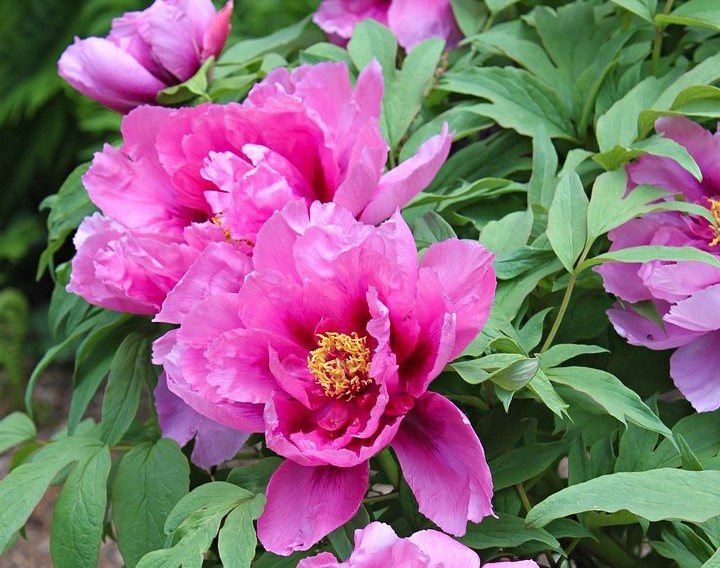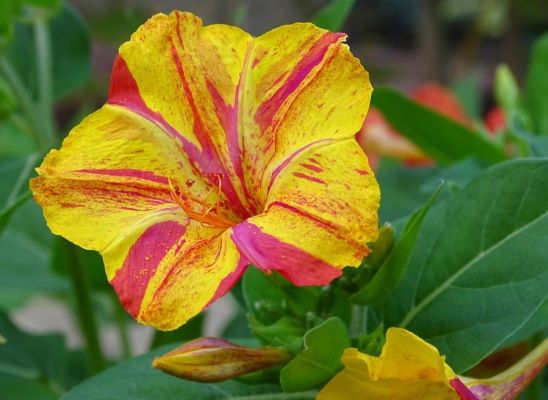Springtime brings an abundance of beauty and color in the floral world, but few can compare to the peony. Native to Asia, Southern Europe and Western North America, the peony has been venerated by poets and gardeners alike for thousands of years. On the whole, peonies are very hardy plants, often thriving and blooming for over 100 years. Let's take a look at the role this plant can play in your garden.

Types of Peonies
The peony comes in three varieties: Herbaceous, Intersectional and Tree.
Herbaceous peonies (Paeonia lactiflora, P. tenuifolia, P. officinalis and others) die back in the winter and reemerge in the spring. They grow between 2 -4 feet tall and are usually just as wide. The blooms on herbaceous peonies range from 2” – 10” in diameter in colors ranging from white to pink to red.
- The tree peony (Paeonia suffruticosa, P. delayvayi and others) is a deciduous shrub and loses its leaves in the fall, but its woody stems remain intact throughout the winter. The tree peony can grow anywhere from 4’ to 10’ tall and will do best in an area with dappled sunlight. All types of peonies grow in USDA zones 3-8, though the tree peonies will also grow in Zone 9, and herbaceous peonies do better in colder climates.
The intersectional, often called 'Itoh', peony is a cross between the herbaceous and tree peony and exhibits the larger blooms of the tree peony but dies back in the winter. They grow about 3’ tall and wide and have a longer blooming period than either the herbaceous or tree peonies. The intersectional varieties also offer more bloom color options including yellows and golds.
- North American native peonies are Brown's peony (P. brownii) and California peony (P. californica). Brown's peony is usually found in mountainous regions of northwest North America, while California peony hails from a limited area in southwest California. Neither would make as grand a show as the other species, but the heavily incised foliage is attractive, and the smaller reddish-brown, yellow-edged flowers are interesting.

Tips for planting, transplanting, and dividing
- Peonies prefer soil with a neutral pH balance that drains well. If your soil is heavy clay or sandy, mix in some compost or other organic matter.
- Space peonies 3-4 feet apart to allow for good air circulation to prevent foliar diseases like powdery mildew.
- For herbaceous and intersectional varieties, choose a location that gets full sun (6 hours) for best blooming. While some peonies can get by with less, all will bloom and grow better with full sun. The tree peony needs dappled light or part sun (3-4 hours) for long life and to prevent the flowers from aging as quickly.
- When siting peonies, consider their year-round effect, as the blooming period is limited. The rest of the season they will make a fine green backdrop for other plants, or an excellent informal low hedge.
- When planting bare root peonies, never place the peony eyes (buds) lower than 2” below the soil line. This will ensure best blooming. If planting containerized plants, plant the top of the soil level with the surrounding ground.
- Commercially grown tree peonies are usually grafted onto P. lactiflora rootstock. For this reason, be sure that the graft union is planted 6 inches below the soil level. This should prevent suckering of the root stock. P. lactiflora shoots are shiny red, while tree peony shoots are a lighter dull red. If suckers appear, check to see if they are originating from below the graft to be sure. Remove P. lactiflora suckers as soon as they appear at the point of origin with a clean, sharp knife.
- Heavy rains when in full bloom can drag the large blooms down to the ground. Help the stems of the peony by providing support through the use of peony rings. If you place them early enough in Spring, the peonies will grow through them and will help them to remain upright as they grow and bloom.
- Don’t kill the ants! The ants you see crawling over your peony buds are just there for the nectar and may help rid your plant of other pests. And you don't need ants to make them bloom--that's just a myth.
- Cut back herbaceous and intersectional peonies to the ground after first frost to avoid overwintering disease. Also remove any diseased foliage immediately during the season and pick up any damaged leaves that may fall to prevent spreading the problem. Fresh foliage will often regrow that season.
- Peonies, unlike other perennials, rarely need dividing. If you want to share with a friend, don’t plan to divide until fall, and make sure you leave 3-5 eyes per clump.
- Lastly, don’t forget that most peonies may not bloom for 1-3 years after planting from bare root or transplanting, so don’t give up on them. With a little time and the right conditions, you will have gorgeous blooms for years and years to come!
Photos in this article courtesy of Ball Horticulture, Inc., www.ballhort.com.

























